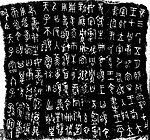Ideographic symbol of iteration
An ideographic iteration symbol is a character or punctuation mark that represents a repeated character or word.
Chinese
In Chinese, the character 二 (pinyin, Èr) (〻 in the vertical script form) or the symbol 々 is used in casual writing to represent a double character, but is never used in formal or printed writing. In a list or table, vertical repetitions can also be represented by the ditto sign (〃).
History
Iteration symbols have been used occasionally for over two thousand years in China. Proof of this is the bronze writing found on a bronze pot from the Zhou dynasty, which ends in "子二孫二寶用", where the small 二 is used as an iteration symbol in the phrase "子子孫孫寶用 » (pinyin, Zǐ zǐsūn sūn bǎo yòng).
Japanese
The Japanese iteration symbols, known natively as odoriji (踊り字 or 躍り 字, &# 39;odoriji'?), odori (おどり, 'odori'?), kurikaeshifugō (繰り返し符号, & #39;kurikaeshifugō'?), kasaneji (重ね字, 'kasaneji' ?), okuriji (送り字, 'okuriji'?), yusuriji (揺すり字, 'yusuriji'?) , jūji (重字, 'jūji'?), jūten (重点, 'jūten' ?) or jōji (畳字, 'jōji'?) are special characters in the Japanese script that indicate the doubling of the character preceding them. There are several iteration symbols for current Japanese writing systems: kanji, hiragana, and katakana.[citation needed]
Kanji
The 々 symbol, whose formal name is dōnojiten (同の字点, ' dōnojiten'?) but is also known as noma (のま, 'noma'?) by the katakana no (ノ) and ma (マ), is the repetition or iteration symbol in Japanese that is used with kanji to represent their repetition, instead of writing it twice. The symbol originates from a simplified form of the character 仝, a variant of 同 ("same") written in cursive form.
Although the iteration symbols used in Japanese are borrowed from Chinese, the grammatical function of doubling differs, as do the conventions in the use of these characters.
While Japanese does not have a grammatical plural form per se, some kanji can be written in duplicate to indicate plurality (as a collective noun, not as many individuals). This differs from Chinese, where characters are often repeated for the sole purpose of emphasis, although there are some rare exceptions (such as 人 rén person, 人人 rénrén all).
Examples:
- .ware, "me") versus ь a (wareware"we"
- (a)milestone, "person") versus a (milestone"people" but not "persons")
- ▪yama, "mountain") in front of 한 a (Yamayama"many mountains" but not "mountains")
However, sometimes the iteration symbol can completely change the meaning:
- ((koor "object" in front of a (kokoor "individually")
- .Toki, "time") versus σ a (tokidoki"Sometimes"
- (日 (yokujitsu, "Next Day") in front of a日本語yokuyokujitsu"the next day" or two days later)
In vertical script, the character 〻 (U+303B), an italic form derived from 二 (as explained above) may be used instead of 々, although this is very rare.
Kana
The hiragana and katakana syllabaries use different iteration symbols: ゝ for hiragana and ヽ for katakana. The iteration symbol is used in names such as さゝき Sasaki or おゝの Ōno, and is also part of the official name of the car company Isuzu (いすゞ, 'Isuzu'?).
Unlike iteration symbols for kanji, which do not reflect sound variations, iteration symbols for kana syllabaries accurately reflect sound variations of some syllables. These can be combined with the dakuten to represent that the repeated syllable is voiced, as in みすゞ Misuzu. If you want to repeat a voiced syllable, for example じじ jiji, you must also use the iteration sign with dakuten: じゞ instead of じゝ, which is read as jishi.
While iteration symbols for kana have been widely used in ancient texts, in modern Japanese they are generally not used outside of proper names, although they may appear in informal manuscripts.
Spanish
In the Spanish language, as well as in the majority of languages in which the Latin alphabet is used, the idem sign (〃) can be used to indicate, informally, that the element above it is repeated. This is common in handwriting, however it is discouraged for formal documents.
- Two liters of milk... $2.25
Four.......... $4.50
Contenido relacionado
Romansh
Nihon-shiki
Terminative case
